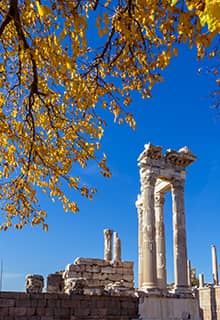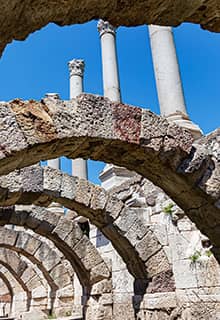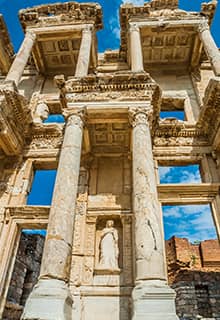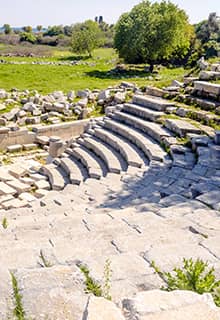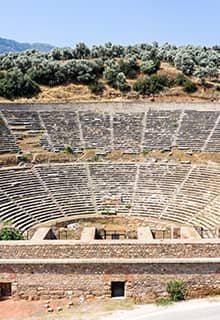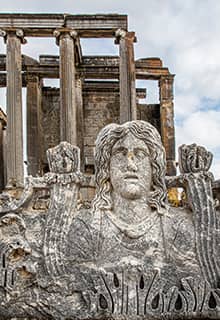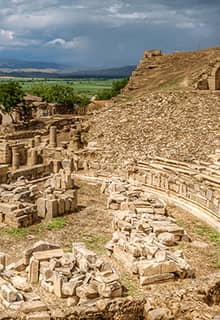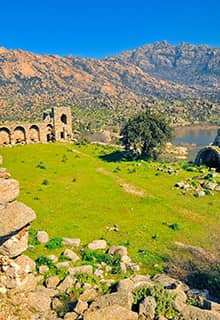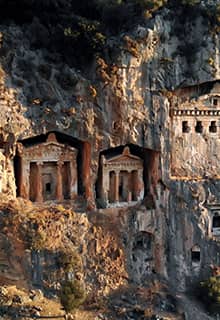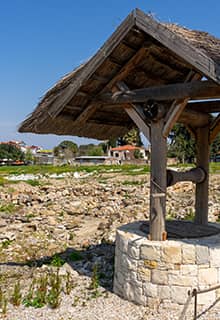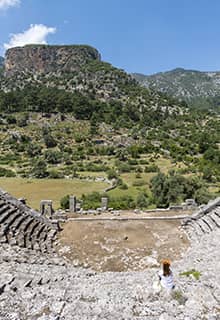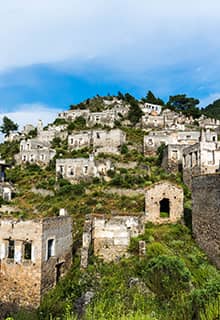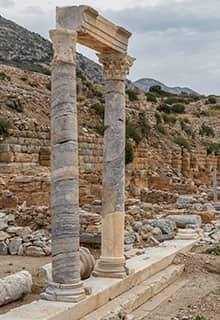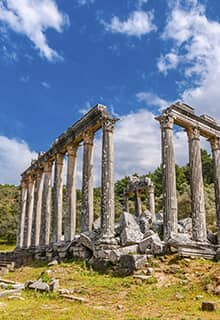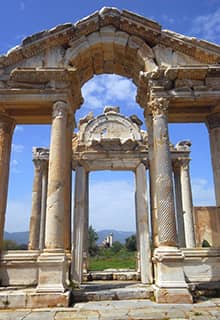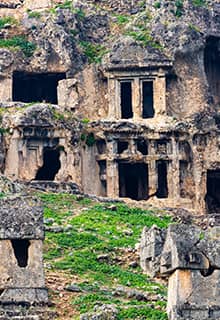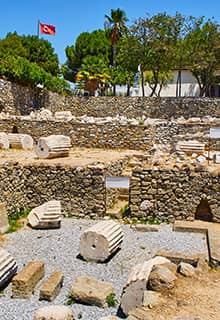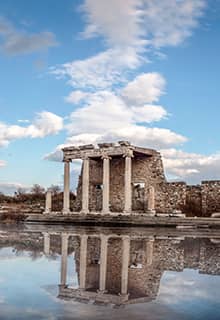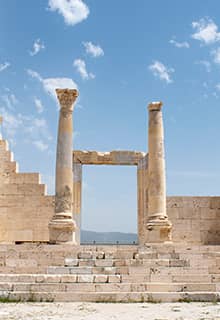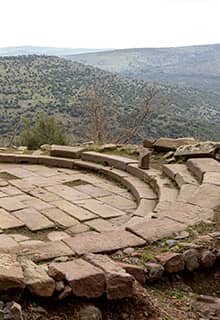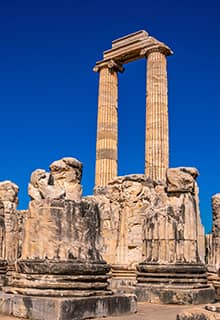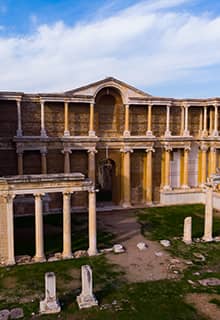

historical sites Aegean
Türkiye
Tlos, Muğla
Tlos is located at the crossroads, now and in ancient days. One can reach Tlos easily from Fethiye, it is just 35 km North east of Fethiye, 10 km off the main road to Antalya. Hittite King mentions he have conquered Tlawa country, and indeed Lykian name for Tlos was Tlawa, thanks to Turkish archaeologists, they have discovered the earliest known settlements in and around Tlos going back to prehistoric times. The ancient city overlooks the fertile Xanthos Valley, mentioned in the Iliad by Homer, also a certain person named Skylakeus from Tlos is mentioned who have fought the Greeks bravely in Troia. Visitor today enjoys the great acropolis hill decorated with Lykian Rock Cut tombs and a medieval castle at the top, where a Turkish “Bey” used to reside till the 19th century. Just below the acropolis one of the biggest stadia, incorporated into the agora with a pool in the middle can be seen. To the North of the agora, stands the agora building, and two baths still in excellent preservation. The only known temple dedicated to Kronos, father of Zeus was also discovered in Tlos, perhaps related to the native god Tarku. The Christian Basilica Church is also excavated, and beautiful mosaics were uncovered. Finally, the ancient theater lies in alliance with Akdağ, the massive mountain that forms the 2nd highest peak of the Tauros Mountains. A visit to Tlos must also include the Saklıkent gorge, and Fethiye museum where the statues captured from the theater are on display.
Alabanda, Aydın
Alabanda ancient city is located 50 km south of Aydın, on the fertile valley of Çine Çayı, Marsyas river of antiquity. The city founded in the 4th century BCE. Alabanda derives from Carian language, “ala” meaning while “banda” can mean either "victory" or "competition". The city offers well preserved ruins and among them is a nice theater, Hellenistic fortifications, a temple dedicated to Apollo, a bouleuterion and tombs.
Alinda, Aydın
Alinda ancient city is situated some 60 km south of Aydın and 10 km north of Alabanda, just at the edge of the modern city of Karpuzlu. Therefore, a visit to Alabanda and Alinda can be made on the same day. Alinda has never been excavated, however, there are very well-preserved buildings from the Hellenistic and Roman periods. The 3 storied agora building is indeed remarkable with it preservation, standing almost intact. On the hillside above the agora building are the ruins of the city, theater and fortifications which are well preserved.
- Amyzon, Aydın
- Antioch on the Maeander, Aydın
Aphrodisias, Aydın
Aphrodisias is a remarkably preserved city in ancient Caria. The site is located 100 km east of Aydın and can be reached easily from Aydın, İzmir and even from Antalya for a day trip. The city was famous in antiquity for its sanctuary of Aphrodite and its marble sculptors. The city prospered under the Roman empire as Romans claimed their ancestry through Aphrodite and her son Aeneas. The high-quality marble quarries near the city, and the qualified sculptors of Aphrodisias gave city enormous wealth and prosperity during the Roman Empire. The earliest settlement in the city goes back to the Chalcolithic period, the theater hill was a mound this period through the Bronze Age. As it was away from the coastline and any main routes of the modern period, the city was not robbed and when archaeologists discovered the city in the 19th century, almost all material was still there. Extensive excavations of the Turkish and British archaeologists for over 60 years, revealed several buildings, and hundreds of statues of high quality. These statues and excellent reliefs are on display at Aphrodisias Museum on site. The restorations of the Propylon and Sebasteion, give visitor a great idea how the city once looked like. The theater, agora, odeon – bouleuterion, baths, the biggest Stadion in Türkiye with a capacity of 30.000 people are almost intact. The Geyre village, which once built over the ancient city, makes a nice appearance with its traditional houses and architecture.
Didyma, Aydın
The Temple at Didim, ancient Didyma is situated at Yenihisar, 100 km to Aydın and 160 km to İzmir. Prof. Bean describes the temple as “thanks to temple at Didyma, it stands as a reminder that vastness in architecture is not a monopoly of the Roman Period”. Indeed, the temple from the Hellenistic period is a massive structure and hardly any monument from this period exceeds the size of it. Didyma was not a city but the shrine related to Miletos, the great maritime city of the Archaic period, it was connected to Miletos with a 17 km sacred way. The excavations showed that the area was inhabited as an oracle center as early as the 8th century BCE, and name, like in İdyma or Sidyma was linked to Anatolian Luwian language. In the 3rd century BCE, it is recalled as one of the most important oracle centers of the ancient world. The temple in in the Ionic order, a dipteros, meaning that either sides of the temple contained two rows of columns. It is a unique structure as there is not direct entrance to the cella, but entrance was provided by two tunnels, and instead of a roofed cella as we are used to see, the cella was never roofed and another temple in antis was built inside to serve where the cult statue of the god will be placed. The stadion that was attached to the temple is also a unique application and was serving the guests to enjoy while waiting for the priests to perform the oracles.
Latmos, Aydın (Herakleia and Latmos)
Latmos, or Herakleia and Latmos is located just next to lake Bafa once the gulf on the Aegean before the meander River silted its opening to the sea and turned it into a brackish lake. It is located 120 km to Muğla and 85 km to Bodrum. It is also possible to reach Kapıkırı village by boat from Milas- Soke road. One of the many cities dedicated to Herakles, the ancient city, picturesque olive village of Kapıkırı and monumental Latmos mountain in the background makes this place extremely scenic and pleasant to walk through. Endymion of Herakleia was famous for the legend about his love to the moon goddess Selene, and we know that Endymion was an astronomer who was able to measure the true orbit of the moon. The city walls are preserved in excellent condition, and one can walk almost all the walls starting from the city gate. The temple of Athena, overlooking the Bafa lake, is preserved to its original height. The theater and the bouleuterion are also in good preservation. One must take time and get a local guide from the village to see the prehistoric wall paintings which are abundant around the city, however at considerable distances.
Magnesia on the Maeander, Aydın
One of the two famous Magnesia ancient city is modern day Manisa, however the other one with beautiful ruins and landscape is on the Meander valley. Magnesia on the Meander is located 35 km from Aydın and can be reached easily from the main road to Söke. According to Greek tradition, Magnesia on the Meander was founded by the colonists from the tribe of Magnetes who arrived in Anatolia from Thessaly. According to Homer, they took part in the Trojan War as a part of the Greek troops led by Agamemnon. The main cult of the city was Artemis, and a beautiful Ionic temple was built for Artemis, which welcomes the visitor. Thanks, the Turkish excavations that revealed most of the city including the theater, stadion, baths and the main street of the city.
Miletos (Leading city of Ionian League), Aydın
Miletos lies some 85 km from Aydın and 35 km from Söke, on the meander valley. A visit to Priene, Miletos and Didyma can be done on a day trip as all three cities are close to each other. Once the great maritime city of the archaic period, Miletos was politically and economically the indeed the most powerful city in Ionia in its early days. We hear from ancient sources that they have established more than 90 colonies along the Aegean and Black sea including Sinope, and Amisos. Brillant intellectual achievements followed this wealth and prosperity, Thales, Anaximander and Anaximandros are considered to be the first nature philosophers of the ancient world. Thales, for the first time, examined natural phenomena only for the sake of his curiosity and daily practical needs. His followers, Anaximander and Anaximandros tried to explain things by observing the nature instead of accepting them as act of pagan gods. Today’s modern science agrees Miletos as the birthplace of modern science and philosophy. As Meander valley silted up the harbors of Miletos, by the end of the 3rd century BCE, Miletos was left without a harbor and todays visitor can only see vast fields around the city. As the city was entirely rebuilt during the Hellenistic and Roman Periods, little is left from the great archaic city. One can still see the grid, or the Hippodamic plan, applied by Hippodomos of Miletos. The great theater of Miletos is dominant as you enter the city, and it is in an incredibly good preservation. The agora, partly restored stoa, delphinion, Roman and Turkish baths, the bouleuterion, İlyas Bey Mosque and Faustina baths are some of the remarkable structures of Miletos.
- Myus, Aydın
- Notion, Aydın
Nysa, Aydın
Nysa is another wonderful ancient city situated on the Meander Valley. It is only 30 km from Aydın, at Sultanhisar, on the main road from Aydın to Denizli. The impressive Messogis mountain behind Nysa, gives the city a spectacular look. In mythology, Dionysus, wine god, was born in Nysa or Nyssa, a name that was consequently given to many towns in all parts of the world associated with cultivation of grapes. The name "Nysa" is also mentioned in Homer's Iliad, which refers to a hero named Lycurgus, "who once drove the nursing mothers of wine-crazed Dionysus over the sacred mountains of Nysa". The city was founded in the 3rd century BCE, by Antiochus I Soter, giving the name of wife, Nysa to this town. Thanks, the recent excavations there is much to see at Nysa, a great theater, the agora and stoas, the baths and the water tunnel, aqueducts are still in particularly good preservation. The olive orchards that surround the city add a lot to the scenery.
Priene, Aydın
Priene is located 65 km west of Aydın, and only 15 km to Söke. The city changed its location at least two times in history, due to silting process of the Meander Valley. The present city was established here in the 4th century BCE, and its prior location remains a mystery, buried somewhere under the meander valley. Although Priene was not as important as Miletos or Ephesus in Ionia, hosting the Panionion meetings gave the city an exceptional privilege. Panionion was a political organization where Ionians met to discuss issues about Ionia and the place where they gathered was always in Priene’s territory. One of the seven sages of antiquity, Bias, a famous lawyer and known for his valuable advices, was from Priene. Today visitor to Priene witness’ a purely Hellenistic city, the city was not over built during the Roman Period as many others were and preserved as it was 2500 years ago. The best designed and preserved ancient theater is here as well as the best designed Ionic Temple, dedicated to Athena. The city walls, agora, Prytaneion, Fish and Meat Market are all in excellent condition. One can also see the “oikos” houses of the Hellenistic period and a magnificent grid plan. If you take a walk down to the well-preserved fortifications, you can also visit the lower gymnasion. Mount Mykele which dominates the city forms a great view.
- Cyzicus, Balıkesir
- Aegospotami, Çanakkale
Knidos, Muğla
Knidos is one of the most attractive locations in Türkiye, situated on the Datça Peninsula that separates the Aegean from the Mediterranean, some 100 km west of resort town Marmaris. It is also on the “Blue Voyage” routes that are made by traditional Turkish wooden yachts. Knidos is a Carian city, and old Knidos has been excavated near Datça. It is understood that the city was moved to its present location to enjoy the wealth of the sea trade. Knidos already became worldwide famous in the ancient days housing the first naked statue of Aphrodite, made by famous Praxiteles. All efforts made up to date to find the statue was fruitless. Another fame of Knidos was the architect Sostratos, who designed the Lighthouse at Alexandria, one of the wonders of the ancient world. Visitor to Knidos today can witness the temple of Aphrodite, agora, two harbors, theater, a sun dial, and several buildings from the ancient days. It is great fun to swim over the ruins of the ancient harbor.
Caryanda - Cadianda, Muğla (Cadianda)
Cadianda is a beautifully located ancient city among the pine forests, above the picturesque village of Üzümlü, became famous in recent years. It is 20 km North of Fethiye and accessible with a decent road. Cadianda was a Lykian city and the Lykian Tombs are a witness of this, especially the one with reliefs is a must to see. The city is very well preserved and tombs, agora, stadion, theater are still in particularly good shape.
- Ceramus, Muğla
Euromos, Muğla
Euromos is a located 29 km west of Milas, just next to the main road that leads from Milas to Söke. It is one of the important cities of Caria, and the almost intact temple of Zeus at Euromos make the city a must to visit. The temple is in the Corinthian order, and almost all columns are still standing, bearing benefactory inscriptions. Recent excavations in Euromos revealed the theater, agora, and several other buildings besides the temple.
Halicarnassos (Home to the Wonder of the Ancient World: Mausoleum of Halicarnassus), Muğla
The “ss” in Halicarnassos suggests the Luwian origin of the city rather than Greek. The capital city of Caria was Mylasa until the 5th century BCE, when the kings of Mylasa decided that they should get more benefit from the sea trade that was growing, they moved their capital to Halicarnassos, and the city became and remained as the capital city of Caria since. Famous historian Herodotos is from Halicarnassos, and also King Mausollos, who was honored with a monumental tomb by her wife, Queen Artemisia which was considered as one the wonders of the ancient world. When Mausollos dies, his wife Artemisia took the ruling power as an ally to Persians and gave hard time to the Greeks. After the defeat of the Persians, her sister, Queen Ada was replaced by Alexander the Great. The Nights of St. Jean build the biggest crusader castle on the Mediterranean here, dedicated the city to St. Peter, and re named the city Petronium, which turned into Bodrum with Turkish occupation. Famous Turkish author and historian, “Halikarnas Balıkçısı”, fisherman of Halicarnassos, was exiled to Bodrum who introduced the “Blue Voyage”, a sea vacation on traditional wooden Bodrum Yachts, and Bodrum became worldwide famous. The shipwrecks excavated along the Mediterranean are also displayed in the castle, and this became the biggest underwater archaeological museum in the world.
Kaunos, Muğla
“Harpagos marched through Carians, Kaunisians and Lykians” says historian Herodotos of Halicarnassos. We understand from this passage that although Kaunos was in the border of Lykia and Caria, it was mentioned somewhat separate. Dalyan on the bank of the Dalyan River, the ancient Chalbis, which connects Lake Koycegiz to the Mediterranean. A short boat ride along the river will take you to the lovely site of the ancient Karian city of Caunos. Located near the harbor, the agora with its Hellenistic stoa, the Shrine for Aphrodite Euploia and the nypmhaion was the vital center of the town. The inscriptions on one of the walls of the nymphaion are regulations for customs, which give us a good idea of the economic situation of the town in the second century. The Roman bath, theater, and measuring platform lie on the upper terrace overlooking the town. Recent excavations have revealed earlier layers of construction under this terrace. One must also visit the beach where the river meets the Mediterranean. This beach is one of the well-known spots where Caretta Caretta, the logger headed giant sea turtles, lay their eggs during the summer.
Kayaköy, Muğla (Karmylassos – Levissi)
Ancient Karmylassos, medieval times Levissi and today it is called Kayaköy, a haunted village which was left after the population exchange between Türkiye and Greece in 1923. You can reach Kayaköy from Fethiye within 30 minutes. Although except few Lykian rock cut tombs nothing much survived from the ancient city, the Greek Town which was abandoned in 1923 survives almost intact. Walking amongst the cobble stone streets of Kayaköy, gives you a sad feeling, witnessing a tragedy of the first world war. The houses are usually painted in blue and red, almost every house has a cistern, there is a huge school building, 2 big churches and several chapels. Those who have time should also take the Lykian Way leading to Ölüdeniz from Kayaköy.
Labraunda, Muğla
Labraunda is just 16 km from Milas, however there is no local transportation therefore one must drive to the city. The peculiar rock formations of the area add a lot to the scenery, and the ancient city is indeed well preserved. This was probably not a city, but a shrine for Carian rulers. Historian Herodotos mentions the name of the city already in the 5th century BCE, in relation with rebellion against Persians. The area was dedicated to Zeus Labrynthos, Labrys meaning “double sided axe”, a Carian symbol of Zeus; and worship of Zeus was dominant at Labraunda from the 5th century BCE until the Christian era. The andirons, fountains, temple, and the roofed tomb preserved in excellent condition are worthwhile to see.
- Myndus, Muğla
Oenoanda, Muğla
Oenoanda is situated some 60 km northeast of Fethiye, near İncealiler Village. From the village a steep path leeds up to the ancient city and there is no road climbing up, so the visitor should be prepared for a walk. The city lies in a beautiful black pine forest and it can be cold and snowy during winter due to its high altitude. The name is an Anatolian Luwian name, driving from “Wiyanwanda” to “Oinoanda”, both meaning wine country. The city has wonderful fortifications, agora, temples, and public buildings. Perhaps one of the most interesting finds of the city was the inscriptions of Diogenes of Oenoanda. He was an Epicurean from the 2nd century CE who carved a summary of the philosophy of Epicurus onto a portico wall in Oenoanda. The surviving fragments are form an important source of Epicurean philosophy. The inscription, written in Greek, sets out Epicurus' teachings on physics, epistemology, and ethics. It was originally about 25,000 words long and filled 260 square meters of wall space.
Pınara, Muğla
Pınara is about 50 km east of Fethiye and one can either take the main coastal road, or the scenic drive overlooking the Mediterranean from Ölüdeniz via Sidyma. Name in Lykian is Pilleni, and both meaning “round”, deriving from the rock behind the city which is round. Pandaros, a hero mentioned in the Iliad during the Trojan war is from Pınara. The city lies in a beautiful forest makes the visit very pleasant. The theater is almost intact and there are hundreds of Lykian rock Cut tombs, some with reliefs, and one of them bearing the city relief on the side walls. The round rock behind the city is filled with “pigeon” type Lykian Rock tombs, and the western side contains several house and temple type tombs. The agora, temples, colonnaded street can be seen in the main area of the city.
Stratonikeia, Muğla
Stratonikeia lies 50 km East of Muğla, the provincial capital of the area, near the Eskihisar village. According to historical sources, the city was established by Antiochos for his was Stratonike in the 3rd century BCE. The city gate, agora, bouleuterion, well preserved tombs can be seen in the city. The houses of old village of Eskihisar also adds a lot to the beauty of the city.
Telmessos, Muğla
Telmessos, modern resort town of Fethiye, is the last large Lykian city on the west, before Caria land begins. Today the modern city developed just over the ancient city, leaving most of the ruins buried underneath the modern town of Fethiye. Nevertheless, The Lykian house and temple type tombs are magnificent, and the Temple of Tomb of king Amyntas is a masterpiece of the Lykian funeral architecture. The ancient theater was also discovered within the city in 1993.
Aigai, Manisa
Aigai is a less visited, yet a wonderful ancient city on the North Aegean, 50 km north of Manisa, 50 km south of Pergamum. The city was a bishopric in Aeolis. Aegae is mentioned by both Herodotos and Strabon as being a member of the Aeolian dodecapolis. It was also an important sanctuary of Apollo. Aigai had its brightest period under the Attalid dynasty, which ruled from nearby Pergamum in the 3rd and 2nd century BCE. The site is situated at a rather high altitude almost on top of Mount Gün, part of the mountain chain of Yunt Mountains. The location of the city is attractive to walk and the landscape is wonderful. The excavations unearthed the ancient streets, agora building, tombs are interesting finds to see.
Sardis (Capital of Lydia), Manisa
Sardes, or Sardis is located on the Gediz, ancient Hermos valley 80 km east of İzmir, on the main road to Ankara, at the village of Sart. It was an important ancient city and capital of the kingdom of Lydia, during the 6th century BCE. Its strategic location made it a center connecting the hinterlands of Anatolia to the Aegean. Lydian ruler, Croesus, the last Lydian king, paid for the construction of the temple of Artemis, which became one of the Seven Wonders of the Ancient World. In 656 BCE, Lydian Kingdom was overrun by the Persians and the city lost its importance. Sardis began as a hilltop citadel where Lydian kings lived, and the city developed to lower town, located along the banks of the Pactolos River, where the ordinary citizens lived, and the upper town for the wealthy citizens, royal members, and the palace. Lydians are the first people who discovered monetary system as we understand today. The Pactolos River, bearing rich gold mines made the Lydians wealthy, hence the term “Rich as Croesus”. The city today lies on both sides of the modern road. To the North is the magnificent Gymnasion, synagogue, and the south part one can see the great temple of Artemis and a church attached to it. Sardes is also listed as one of the 7 churches of Asia Minor, to whom St. John wrote letters.
- Stratonicea, Manisa
- Allianoi, İzmir
- Apollonia, İzmir
- Atarneus, İzmir
- Colophon, İzmir
Colophon, ancient Ionian city, located about 25 km northwest of Ephesus. It was a flourishing commercial city from the 8th to the 5th century BCE, with its harbor at Notion. Colophon was famous for its cavalry, its luxury, and its production of rosin. It was the birthplace of the philosopher Xenophanes and the home of the poet Antimachos. Only a few 4th–3rd century foundations are visible of the old walled city, which rose in terraced segments from a fertile valley.
- Cyme, İzmir
Ephesus (Home to the Wonder of the Ancient World: Temple of Artemis), İzmir
The bronze age kingdom of Arzawa, had a capital city called Apasas, which became Ephesus in the 1st millennium. Ephesus lies 70 km south of İzmir, near the modern town of Seljuk. Recent excavations at Aya Soluk hill, revealed the traces of this bronze age city, as well as a Mycenean settlement on the same hill. Further excavations on the small meander valley unearthed a Neolithic settlement at Ephesus. The archaic Ephesus was settled around the temple of Artemis, under the modern town of Seljuk today. The Artemis of Ephesus was a direct continuation of the Anatolian Mother Goddess and she was called the Ephesian Artemis, entirely different from the Greek Artemis, the huntress and the daughter of Zeus. The earliest temple goes back to the 8th century BCE, and was rebuilt at least three more times, eventually the one that was built in the 4th century BCE was recognized as one of the wonders of the ancient world. This old city was moved to its present location perhaps during the 1st century BCE, as a result of silting of the Kaistros river. When Augustus declared himself as Roman Emperor and made Ephesus the capital city of the Roman Empire to Asia, this new city grew enormously, and had a life span of almost 1000 years in glory, until the small meander, Kaistros, silted up the harbors of new Ephesus too. The city has been excavated by the Austrian Archaeological Institute for over 120 years now, and several restoration works have achieved. The theater is the biggest of all Türkiye with a capacity of 30.000 seats. Marble streets, The Celsus Library, Agora gate, Hadrian’s temple and the terrace houses are extraordinary restoration and conservation works at Ephesus. Baths, gymnasion, civil and state agora are in excellent preservation. A full day at Ephesus would not be sufficient to see all the city. The nearby House of Mary is also a pilgrimage place as well as the church and tomb of St. John. Seljuk Museum houses wonderful artifacts from Ephesus and surroundings.
- Erythrae, İzmir
- Gambrion, İzmir
- Gryneion, İzmir
Klazomenai, İzmir
Klazomenai is situated at modern day Urla, some 45 km west of İzmir. It was founded on the mainland near the base of the Erythraean peninsula and became part of the Ionian Dodecapolis and was well known for its painted terra-cotta sarcophagi dating back to the 6th century BCE. Later, its inhabitants, alarmed by Persian encroachments, moved the city to an island 400 yards from the coast. Alexander the Great built a pier to connect the island to the mainland. Today the ancient city is surrounded by olive orchards and one can visit an ancient olive press in the city. Most of the artifacts from Klazomenai are on display in İzmir Museum.
- Lebedus, İzmir
Limantepe, İzmir
When Limantepe excavations first begin, the fortification walls from the Bronze Age made people think of another high civilization along the Aegean like Troia. It is situated 45 km west of İzmir, at Urla. This is a Bronze Age site situated within the urban zone of the coastal town of Urla near İzmir in western Türkiye. It was a harbor settlement inhabited from 4th millennium and apparently equipped with a fortification wall partially submerged in the sea along the shore significantly transformed in time, Limantepe is one of the oldest known artificial harbors in the Aegean Sea.
The excavations continue simultaneously on land and underwater since 1979 by an international team and many of the artifacts discovered are currently on display in İzmir Archaeology Museum. It is close but separate from the site of Klazomenai, inhabited as of the Iron Age and which itself had changed location several times during its history in the same area between the mainland and Karantina Island across its coastline.
Metropolis, İzmir
The Ancient City of Metropolis, which is one of Türkiye’s most rare and precious archeological treasures, is located in Yeniköy, 45 km east of İzmir. Rising on a hill between the villages of Yeniköy and Özbey to the west of the Torbalı Plain, Ancient City of Metropolis was founded in the 3rd century BCE by Lysimachos. During the Hellenistic period the city was surrounded by magnificent fortifications. A temple was built in the name of Ares, the god of war, and monumental public buildings such as stoa and theater were also built. Metropolis was also a sculpture center of the Hellenistic period and produced high quality statues. from the Roman Empire, the Atrium, Roman House, temples of Zeus and the Twelve Gods have managed to survive. “Metropolis’ means ‘city of the mother goddess’ and the statue of Mother Goddess, Meter Gallesia, who gave her name to the city, was found in the excavations at Uyuzdere. During the Byzantine period, the city became the center of the bishopric.
Pergamum, İzmir
The great Kingdom of the Hellenistic period, Pergamum was the political and intellectual center of the Aegean. Located at the modern town of Bergama, some 115 km north of İzmir. The research made in the area shows that the settlement goes back to prehistoric times. However, the city became a great capital of a kingdom in the 4th century BCE, during the time of Philetaerus, who was followed by Attalos who declared him as the king. The Pergamum kingdom is called The Attalid kingdom as well. Especially in the 3rd century BCE, during the reign of Eumenes, Pergamum was controlling almost the entire Aegean. The city was not only politically strong, but as a result of intellectual prosperity, Pergamene paper (parchment) was invented and the library of Pergamum totaled almost 200.000 volumes of books rivaling to the one in Alexandria. The Asklepion at the city was one of the biggest healing centers in the ancient world. It’s last king, Attalus III, bequeathed his kingdom to Rome, and the Roman supremacy started in Asia Minor through Pergamum. The city enjoyed being an important center during the Roman and Byzantine periods, and it was one of the 7 cities whom St. John addressed his letters. The city can be visited in two parts, the Acropolis, and the lower city. Acropolis was modelled a typical Anatolian type that we see both at Troia and Hattusa, a well defended hill surrounded with fortifications and the royal palaces as well as the basic needs for this palace such as storages and cisterns. One of the biggest projects of the Hellenistic period was the Altar of Zeus, constructed to commemorate the victory over Gauls, which is in Berlin Museum. Another giant structure on the acropolis hill is the Trajan temple from the Roman Period. Visitor must take a full day walk from the acropolis to modern town of Bergama and also see the entire city situated on the hillside. The Red Hall at the edge of Bergama is also a monument that should not be missed. Perhaps visiting the Museum in Bergama will add a lot to complete the visit, before visiting the Asklepia, the hospital which is well preserved.
- Perperene, İzmir
Phocaea, İzmir
If you go to Marseilles, you will see a seal drawing at the entrance of the city hall. Phocaea probably meant seal, and this is where the city took its name, and one of the numerous colonies of the city was Marseilles in modern dah France. The city is in Ionia, however like many other Ionian cities’ excavations showed that the early settlement goes back to the bronze age. Modern name is Foça; a town situated at about 70 km northwest of İzmir. Phocaea, was one of the most important settlements of Ionia at the early stage, started in the 9th century BCE. In addition, Phocaeans were known as one of the first in Ionia to mint "electron" coins using natural gold-silver mixture. The ancient city of Phocaea and modern town of Foça are exactly on the same spot so one can enjoy the castle, the ancient ruins and the lovely modern day town of Foça at the same time. A boat trip around Foça will take you to crystal clear waters where seals still live, and the famous siren rocks that are mentioned in Odyssey.
- Pitane, İzmir
Smyrna, İzmir
İzmir is called “The Pearl of Aegean “and indeed, once Smyrna and now modern day of İzmir has always been an important political and cultural city. According to the Yeşilova Höyük excavations carried out in Bornova, the region dates back to the third millennium BCE, and it was one of the strongest cities belonging to the Ionian League. Smyrna had the honor of having Homer as a resident. During the Roman Period, Smyrna was competing with Pergamum and Ephesus over the title of “First City of Asia.” Bayraklı excavations revealed that this was one of the earliest Ionian settlements on the Aegean. Even the modern town if İzmir is directly on the ancient city, the agora area and the İzmir Museum offer a lot to see to modern day visitor. Kadifekale is also an important part of the city with the great view of the Gulf. Smyrna was one of the cities whom St. John addressed his letters, thus, one of the 7 churches of revelation.
- Temnos, İzmir
Teos, İzmir
Located 55 km west, south west of İzmir, near the beautiful resort town of Sığacık. The city was first founded in 1050-1000 BCE and was one of the 12 Ionian cities according to Herodotos. It is also known as the city of Dionysos, the god of wine, Bacchus of the Roman world. Teos is also the city where the first players' guild was formed in history. One can visit the famous Temple of Dionysos, the theatre, the agora, the city walls, the remnants of the port, the bouleuterion, and the gymnasion.
- Attuda, Denizli
- Beycesultan, Denizli
Hierapolis, Denizli (Pamukkale)
The “Holly City, Hierapolis lies 25 km North of modern town of Denizli, at the modern town and natural phenomena of Pamukkale, Cotton Castle. Deriving from springs in a cliff almost 200m above the plain of Çürüksu, calcite-laden waters have created an unreal landscape, made up of mineral forests, petrified waterfalls and a series of terraced basins given the name of Cotton Castle. It is an extraordinary landscape for visitors to the nearby Hellenistic spa town of Hierapolis, founded by the Attalid kings of Pergamum at the end of the 2nd century BCE, at the site of an ancient cult. Hierapolis flourished, reaching its peak of importance in the 2nd and 3rd centuries CE. Remains include baths, temple ruins, a monumental arch, a nymphaeum, a necropolis, and a theatre. Following the acceptance of Christianity by the emperor Constantine and his establishment of Constantinople as the ‘New Rome’ in 330 A.D., the town was made a bishopric. As the place of St. Philip’s martyrdom in 80 A.D.
- Honaz, Denizli
Laodicea on the Lycus, Denizli (Laodikeia)
Laodicea is situated 7 km from Denizli, close to the main road leading to Pamukkale. Thanks to recent Turkish excavations, the ancient city, which was once buried under the debris, is now like a new-built-ancient-city, as almost all the city is excavated and rebuilt. Laodicea on the Lycus river is at the crossroads of important trade routes, a prosperous city, famous for its black wool, banking services, and medical achievements. In the times of late antiquity, it had a large Jewish community and a significant congregation of Christians. St. John mentioned Laodicea as one of the Seven Churches of Asia in the Book of Revelation. The city is enormous with colonnaded streets, theater, temples, bouleuterion, baths, stadion, fountains, several churches and visitor should spare at least 4-5 hours to visit the enormous city.
- Tabae, Denizli
- Tripolis on the Meander, Denizli
- Pepuza, Uşak
- Tymion, Uşak
Aizanoi, Kütahya
Aizanoi is located some 60 km west of modern town of Kütahya and can be easily reached throughout the year. The city is one of the important classical cities of Phrygia Region, and was inhabited in the early bronze age, between 3000 – 2500 BCE. The city became the metropolis of the area especially from the Hellenistic period onwards. The main cult of the city was a native Anatolian Goddess, “meter steunene” which was also knows as Kybele. The great temple at Aizanoi is still standing to almost to its original height, especially on the east side. The underground chamber is a unique structure of the reman temple architecture and most probably related of dual worshipping to Zeus and Kybele. The only example of theater-stadion complex can also be seen in Aizanoi. The ancient bridges which are still standing were providing transport over the Pankelas River, even up to very recently. There are two large baths and interesting tomb stones scattered around the city.
Amorium, Afyon - Apamea, Phrygia, Afyon - Celaenae, Afyon - Docimium, Afyon
Phrygian Valley (Equinox)
Phrygian Valley is a huge triangle between Afyon, Kütahya and Eskişehir, full of unique and wonderful monuments from the Phrygian period, 9 – 8th centuries BCE. In recent years, a walking trail is also marked in this area and one can take at least a week to walk this beautiful landscape. Otherwise, private transport is a necessity in this area as there is no public transportation. The Goynus Valley, Ayazin, Döğer, Emre Lake areas are full of Phrygian Rock Tombs and temples. These are unique structures and similar ones can neither be found in Greece or other areas. The open-air sanctuary of Yazılıkaya or Midas City, contains some of the most remarkable rock monuments.


